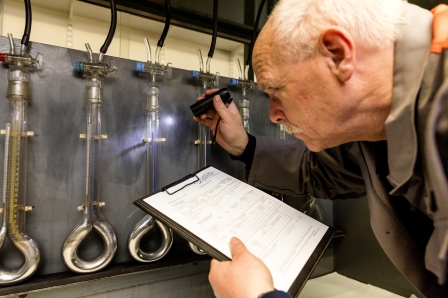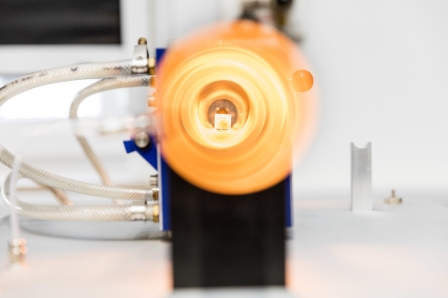Welding technology analysis
Determination of hydrogen in welds
Cracking prevention
Hydrogen-induced cold cracking is a treacherous defect type in the weld seam and in the heat-affected zone – and not merely due of its delayed appearance. Frequent causes include welding filler materials such as SAW fluxes, cored wire electrodes or stick electrodes.
With our accredited analyses (DIN EN ISO 3690), we inspect and qualify weld filler materials with regard to their hydrogen content. We create defined weld specimens and analyze them with the carrier gas hot extraction method or the mercury method.
Cold cracking tests
Cold cracking avoidance
Cold cracks are intercrystalline or transcrystalline material separations in the heat-affected zone or in the weld metal that occur when welding. The general cause is a critical relationship among hydrogen content, mechanical stress and microstructure.
To assess the cold cracking susceptibility of base and filler materials, we offer recognized, self-restraint cold cracking tests, which can also be used for suitability and acceptance testing.
Tekken test: Strict test, especially for base materials.A root pass simulates a restrained butt weld. That butt weld and the heat-affected zone are metallographically analyzed for cracks (applicable standards: DIN EN ISO 17642 and JIS Z 3158 – Japanese industrial standard).
CTS test (Controlled Thermal Severity): A fillet weld is produced as a connection of two sheets under specified conditions. Weld metal and heat-affected zone are then metallographically analyzed for cracks.Additionally hardness is determined in both areas. (CTS test according to DIN EN ISO 17642).
WIC test (Welding Institute of Canada): Quantitative estimation of cold cracking susceptibility of low-alloy steels in the weld metal and in the heat-affected zone. The main application is the assessment of root pass areas of pipegirth welds (preheat temperature depending on wall thickness). WIC test according to the specification CSA W47.1.
Moisture tests
Control instrument in welding technology-based manufacturing
To prevent hydrogen-induced cold cracking, the moisture content of electrode coatings and welding fluxes ideally comply with a specified value.
Both for control during production and for in-process monitoring in welding technology-based manufacturing operations, we offer moisture analysis based on the infrared method (AWS A 4.4M).
Weldability tests
Material qualification
Whether it involves pipe or sheet material that meets the prescribed mechanical-technological properties in the heat-affected zone, we inspect with welding tests. These properties are specified in the general regulations (DNV OS-F101, API RP 2Z, DIN EN 10225 or API 1104 etc.) as well as in special customer specifications. We have extensive experience with all standard welding processes:
- Gas metal arc welding (GMAW) - also fully mechanical out-of-position welding
- Manual metal-arc welding (MMA)
- Submerged arc welding (SAW)
- Tungsten inert gas welding (GTAW)
We offer weldability tests (welding tests) on many base materials:
- Pipeline steels (up to X100)
- Construction steels (up to S1300)
- Cr-Ni steels
- Ni-based materials
Bead-on-plate (pipe) test
In assessing the weldability of steel materials, the tendency of the material to harden in the heat-affected zone is an important criterion. We determine this property quantitatively with a GTA deposition weld.
Welding parameters, preheat temperatures and other conditions are specified in British Standard BS 7363.
Determination of the joinability of thin steel sheet according to SEP 1220
Documentation of compatibility throughout the manufacturing process
Proof of the joining technology processability of a material is generally determined for each joining method according to SEP 1220 (Stahl-Eisen-Prüfblatt = test specification for iron and steel).
Material release process for resistance spot welding (SEP 1220-2)
![[Translate to Englisch:] Foto zeigt Werkstofffreigabeuntersuchung Punktschweißen](/fileadmin/footage/MEDIA/gesellschaften/szmf/Warum_wir/Bilder-Referenzprojekte/Werkstofffreigabe-Punktschweissen-210x140px.jpg)
![[Translate to Englisch:] Foto zeigt Detail zur Werkstofffreigabeuntersuchung Punktschweißen](/fileadmin/footage/MEDIA/gesellschaften/szmf/Warum_wir/Bilder-Referenzprojekte/Werkstofffreigabe-Punktschweissen1-210x140px.jpg)
SEP 1220-2 covers
- Shape and preparation of specimens
- Applicable test methods and conditions
- Testing requirements
- Documentation of test data for customers
Material release process for laser beam welding (EP 1220-3)
![[Translate to Englisch:] Foto zeigt 16 kW-Laserschweißzelle mit Festkörperlaser.](/fileadmin/footage/MEDIA/gesellschaften/szmf/Warum_wir/Bilder-Referenzprojekte/Laserschweisszelle-210x138px.jpg)
Specimen shapes and testing conditions are essentially comparable to those of SEP 1220-2 for spot welding. As a quality limit for a specified laser power, the test considers the maximum achievable feed rate at which full penetration can still be reached on the doubling of the analyzed sheet material. Unlike with SEP 1220-2, the welds additionally undergo an X-ray inspection as well as a hot cracking test.
Material release process for gas metal arc brazing (SEP 1220-4) and gas metal arc welding (1220-5)
SEP 1220-4 describes the material release process for gas metal arc brazing and SEP 1220-5 describes the material release process for gas metal arc welding. Specimen shapes and testing conditions are essentially comparable with those of SEP 1220-2. In this case, however, typical methods do not produce lap joints, but rather fillet welds. Testing conditions for gas metal arc brazing and gas metal arc welding are the same. With regard to quality limits, the minimum and maximum allowable connection cross-sections are determined for a specified process speed. Unlike with SEP 1220-2, the welds additionally undergo an X-ray inspection. A hot cracking test is also conducted.


